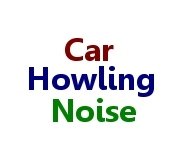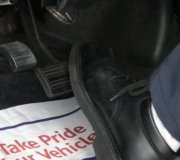Start by checking lug nut torque with a torque wrench. Sounds funny but all professionals have been doing that since the '80s for a number of important reasons. A typical value is around 95 ft / lbs, but 80 is more common with cast wheels.
Next, raise the front end off the ground and run the engine in gear. If you hear the sound, it's not wheels, but look at the brake calipers to see if they're moving side-to-side once per wheel revolution. If they are, you likely have a combination of a warped rotor, which is not uncommon, and grooves worn into the caliper mounting surfaces where the pad backing plates ride. Machining the rotor or putting some high temperature brake grease on the mounts will stop the noise, but machining the rotor is the permanent fix.
Look for anti-rattle hardware that is broken or mispositioned and rubbing on the rotor. There are different configurations so you might have to compare the left and right sides. Look around the inside of the wheel for "witness marks" left by something scraping. Don't overlook a wheel weight that has loosened and is hitting a bracket on the strut. If a brake pad is rattling, it will stop when you put light pressure on the brake pedal.
While the tires are off the ground, grab the wheel on top and bottom with both hands and twist it in and out. There should be no looseness. If there is, check the lower ball joint for sideways movement between the ball and socket. If it's the wheel bearing that is loose, it will allow the wheel to tip in on top, possibly allowing the wheel to rub on the caliper. The wear has to be pretty bad for that to happen. Worn ball joints are fairly common. They will allow the bottom of the wheel to squirt out tipping it in on top. If you need to replace a ball joint, it is a little easier than the less expensive pressed-in ball joints, but thee are a few tricks I can share. No special tools are needed other than a few wrenches, but because of manufacturing tolerances, the car should have an alignment after that service. There is a way to eliminate that need but it involves replacing only one joint at a time.
Front anti-sway bar links have been a real common problem on the Taurus. Unless they changed the design, it is about 15" long, parallel to the strut, and attached to the strut on top. With the wheels on the ground, reach over the top of the tire and wrap your fingertips lightly around the link, then use your arm to raise the vehicle up and down by the fender just a little. If one of the ends is worn, you will feel the clunking with your fingers. There's a ball and socket on each end, and the balls are retained by filling the sockets with molten plastic and expected to last. The link will swivel on the joints but they shouldn't rattle or feel loose. Usually they do not make a metallic sound, but more of a thumping sensation that is felt, not heard.
Caradiodoc
Friday, October 29th, 2010 AT 9:31 PM


